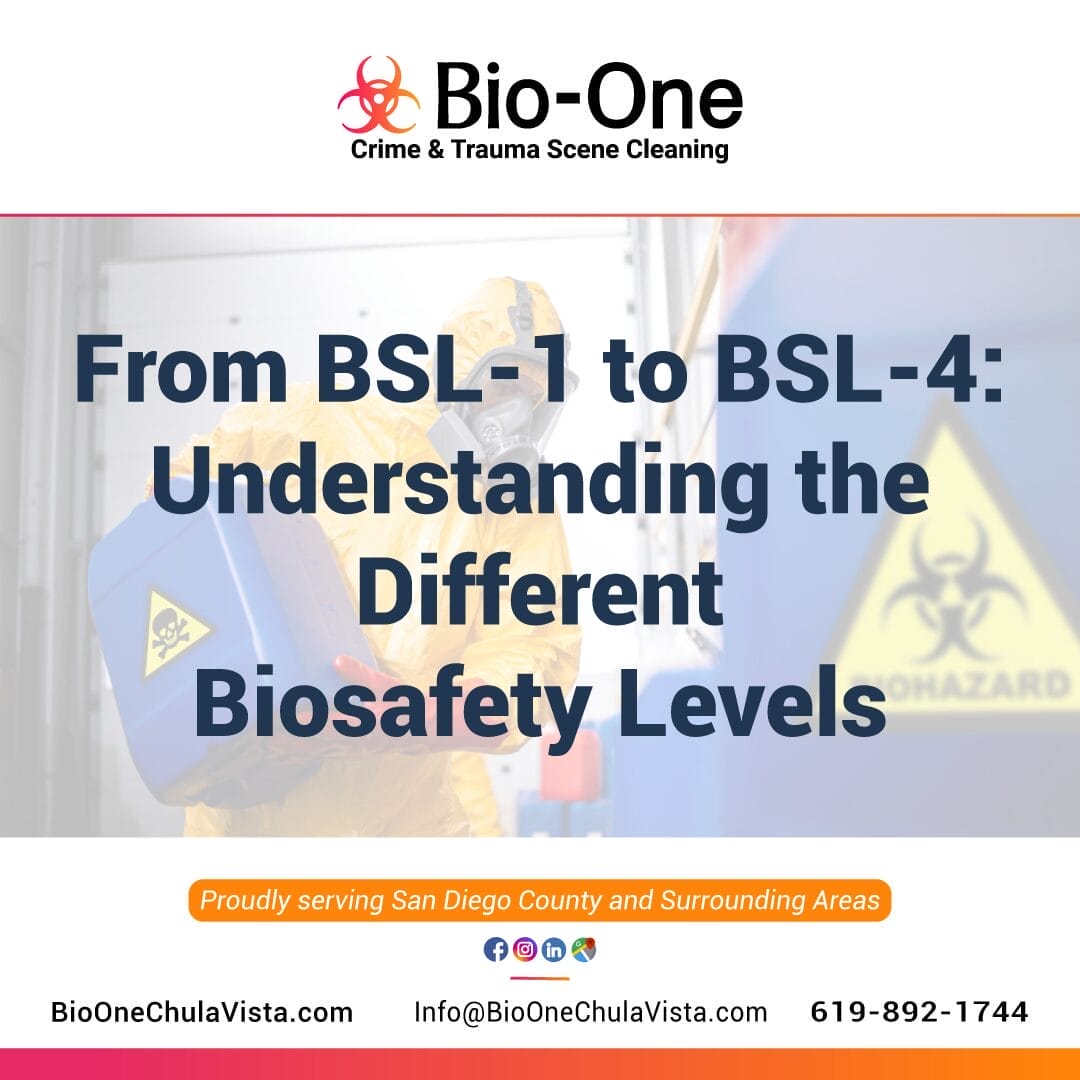
When it comes to dealing with biohazardous waste or potential exposure to biohazardous materials, it is essential to follow strict protocols to avoid contamination and protect oneself and others. Biosafety levels (BSLs) outline a set of containment procedures and practices required to isolate dangerous biological agents to limit exposure. The biosafety levels range from BSL-1, which includes basic precautions, to BSL-4, which includes maximum containment.
In this blog post, we will cover the four biosafety levels and why they are critical for maintaining laboratory safety.
Disclaimer: While we at Bio-One of Chula Vista are a biohazard cleanup company and can manage a broad spectrum of biohazardous or blood-related incidents, we must underscore the seriousness of exposure to a BSL-4 biohazard. These represent the highest level of biohazard threat and require specific, advanced containment procedures. In the event of exposure or suspected exposure to a BSL-4 biohazard, it is imperative to immediately contact your local authorities for notification and assistance. Our team is always here to support with cleanup and decontamination post-incident, but proper reporting and initial response must be handled by official responding agencies for your safety and the safety of the community.
Biosafety Levels - Level 1 - BSL-1
This level of biosafety is the lowest and only requires basic containment measures, such as having appropriate personal protective equipment (PPE) and proper handwashing facilities. BSL-1 labs work with agents that are not known to cause disease in healthy humans and pose no threat to the environment. Examples of agents commonly found in BSL-1 labs include non-pathogenic E.coli and Bacillus subtilis.

Biosafety Levels - Level 2 - BSL-2
The next level of biosafety, BSL-2, is appropriate for work with agents that pose a moderate risk to human health. Examples of such agents include Salmonella and Staphylococcus aureus. BSL-2 labs require more secure containment measures than BSL-1 labs, including restricted access, personnel training, and specific procedures for decontamination and disposal of biological waste.
Biosafety Levels - Level 3 - BSL-3

This level of biosafety is appropriate for work with agents that can cause serious, potentially lethal infections through respiratory transmission. Examples of agents found in BSL-3 labs include tuberculosis and West Nile virus. BSL-3 labs require strict procedural controls, including the use of a biological safety cabinet, decontamination procedures, and specialized ventilation systems to keep the agents from escaping the lab.
Biosafety Levels - Level 4 - BSL-4
The highest level is BSL-4, necessary for work with agents that pose life-threatening health hazards and no cure is available. Examples of such agents include Ebola and Marburg viruses. BSL-4 labs are highly restricted, with multiple layers of security, and personnel require extensive training in handling and disposing of these agents.
Immediate Tips Upon Exposure to Biohazards
If you work in a lab with any of these biosafety levels, it's important to know the immediate steps to take should you come into contact with one of the agents. Immediately after exposure, you should:
- Inform your supervisor immediately, if the incident took place in the lab.
- Seek medical attention if necessary and report the incident to your institution's biosafety officer.
These simple steps can help prevent a serious infection and ensure proper containment of the agent. It's also important to follow any additional procedures or protocols set by your lab for dealing with incidents involving dangerous agents.

Bio-One of Chula Vista Can Help
Users, labs, and the community stay protected as each subsequent level of biosafety builds upon the last. The severity of the risk (human life and the environment) should always dictate the level of biosafety required. Not following appropriate biosafety levels could result in health hazards or serious environmental damage.
Stay vigilant and follow the procedures to deal with biohazard materials, no matter the level you are working with. Bio-One of Chula Vista offers biohazard cleanup services, including virus and bacteria remediation. Our team has the necessary training, tools, and equipment to properly handle and dispose of these agents safely. Contact us for more information on how we can help maintain a safe and secure environment.


